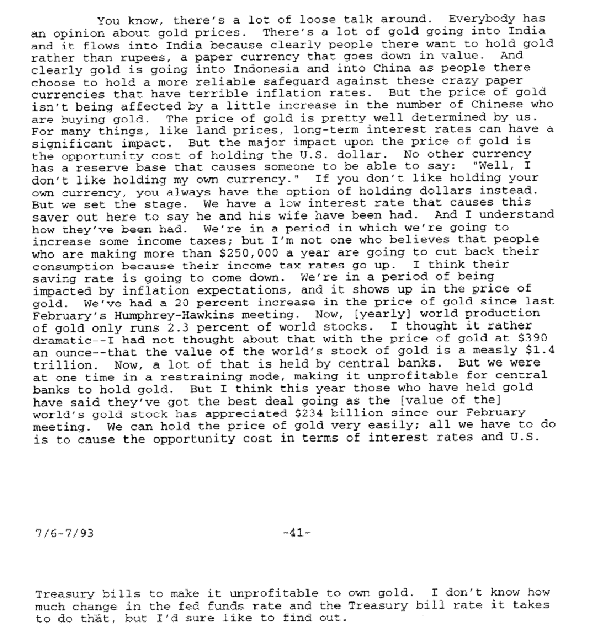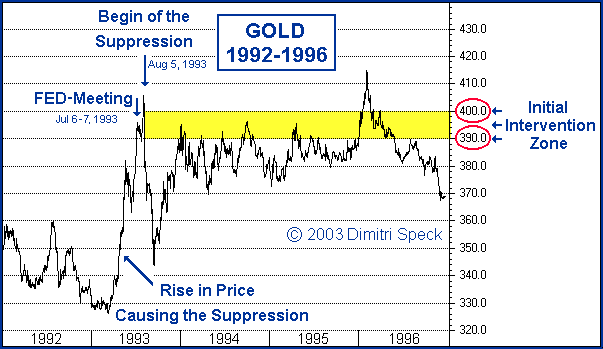-- Posted Monday, 3 February 2003 | Digg This Article
Guest Editorial: Dimitri Speck
The transcript of the last FED-meeting before the gold suppression
began, expresses the wish to "hold the price of gold"
The meeting of the Federal Reserve's Open Market Committee took place on July 6-7, 1993, just a few weeks before the gold price suppression began on August 5, 1993 ( www.gold-eagle.com/editorials_01/speck022301.html ). The transcript refers to the market situation after a very recent twenty percent increase in the price of gold. In addition, it mentions the desire for a low gold price and how it can be achieved.
Before the meeting, FED Governer Wayne Angell mentioned the letter of a saver fearing inflation. Then Angell continued talking about gold and (at the end of our excerpt) about "holding" its price (page 40 / PDF-file page 43 www.federalreserve.gov/.../930706Meeting.PDF ):

Figure 1: Excerpt of the Transcript of the FED-Meeting of July 6-7, 1993
Angell expressed these thoughts just before the gold price suppression began. At that time the suppression probably wasn't developed in detail. Let's look at excerpts of the text:
1.) "...The price of gold is pretty well determined by us. ... long-term interest rates can have a significant impact."
Angell draws a connection between long-term interest rates and the price of gold.
2.) "But the major impact upon the price of gold is the opportunity cost of holding the U.S. dollar. No other currency has a reserve base that causes someone to be able to say: 'Well, I don't like holding my own currency'. If you don't like holding your own currency, you always have the option of holding dollars instead."
Gold and the dollar are competing with each other. But the competitor for other currencies is primarily the dollar.
3.) "... We've had a 20 percent increase in price of gold since last February's Humphrey-Hawkins meeting. Now, [yearly] world production of gold only runs 2.3 percent of world stocks."
The amount of gold in storage is many times the annual production.
4.) "... the value of the world's stock of gold is a measly $1.4 trillion. Now, a lot of that is held by central banks. But we were at one time in a restraining mode, making it unprofitable for central banks to hold gold."
Then he focuses on the gold owned by central banks.
5.) " ... this year those who have held gold have said they've got the best deal going as the [value of the] world's gold stock has appreciated $234 billion since our February meeting. We can hold the price of gold very easily;"
What a sentence! - Gold was a good investment at the time. But Angell is not happy about that, he thinks of "holding the price".
6.) "all we have to do is to cause the opportunity cost in terms of interest rates and U.S. Treasury bills to make it unprofitable to own gold."
He recommends to use the interest rate as a means for suppressing the gold price.
Fear of inflation had caused Angell to talk about gold. Long-term interest rates have an impact on the gold price (1.). Gold is a competitor for the U.S. dollar, the U.S. dollar for other currencies (2.). A low gold price makes gold unprofitable for central banks (4.). So far he just describes the situation.
But then he concluded with the idea to "hold the price of gold". This is caused by the rapid price increase of gold in the first half of 1993. He does not explicitly express the reason for his desire. But we can make assumptions by going through the chain of arguments backwards.
Inversing the logic, one result of "holding" the gold price is, that it becomes unprofitable to own gold (5. + 6.). This might especially refer to the gold ownership of other central banks (e.g. he uses both times the same term "unprofitable"; 4. + 6.). If investors are not interested in price suppressed gold they will invest in other assets, especially in U.S. dollars (2.) and bonds (1.).
Based on this excerpt (including the introduction), he (or somebody else) could have seen the following benefits of a gold price suppression:
A higher U.S. dollar
Lower long-term interest rates
Better sales of treasuries, especially at central banks
Lower inflation
Lower inflation expectations
But how does Angell want to "hold the price of gold"? He mentions the use of Fed Funds rates as a means (6.). This is the standard instrument of central bankers. He does not talk about direct interventions.
However, he does show the direction. Gold is stored in quantities many times the annual production and consumption (3.). By referring to this, Angell acknowledges one fundamental difference between gold and all other commodities.
The large amount of stored gold is the precondition to suppress the price of gold trough interventions over a longer period of time. When Angell talked about "holding" the price of gold on July 6, 1993, he didn't seem to think about direct interventions, but he did recognize their precondition. It only needed somebody to put the peaces of the puzzle together.
The means Angell recommends to "hold" the gold price in form of Fed Funds have the disadvantage, that the Fed Funds would mainly depend on the price of gold. Suppressing it by other means like direct interventions would enable the FED to keep the Fed Funds independent. It suggested itself to suppress the price of gold using the large stock (3.) through interventions via selling or lending.
We will also look briefly at the following FED-meetings. During the next one, which took place on August 17, 1993, and therefore twelve days after the gold price suppression had begun, Angell said (page 41 / PDF-file page 44 www.federalreserve.gov/.../930817Meeting.PDF ): "I recognize that the price of gold has come down from $400 to $371 and that really is a factor that parallels the move that took place in the bond market; and that has worked very, very well." Again he draws a connection between long-term interest rates and the price of gold.
Several months later, on December 21, he states (page 21 / PDF-file page 24 www.federalreserve.gov/.../931221Meeting.PDF ): "... So I would prefer to say the price of gold at $389 an ounce is too high. ... But if you leave policy alone the opportunity cost of [holding] gold will be conducive to the price of gold going above $400. And the longer you let it go and the higher it goes, the greater will be the tradeoff cost of bringing inflation back..." Here, he gives an estimate of a reasonable price. Furthermore, he draws the connection between inflation and gold.
We should not draw too far reaching conclusions based on the FED-transcripts. They do not tell us who is organizing the gold price suppression and how. The first of the meetings took place before the suppression began, and the FED-meetings are not the place where the gold price suppression is being organized. Furthermore, the ultimate cause to start the suppression is not mentioned, presumably problems of short-sellers after the most recent rise of the gold price. Apparently it was the initial goal to keep the price of gold under the psychologically important round decimal number 400.

Figure 2: Price of Gold 1992 - 1996
But what we can see are the thoughts appearing in FED circles on the eve of the gold price suppression, an early still rough picture of the birth of the gold price suppression.
Dimitri Speck
Demetrius.Speck@gmx.net
(c) 2003 Dimitri Speck - www.seasonal-charts.com
-- Posted Monday, 3 February 2003 | Digg This Article

